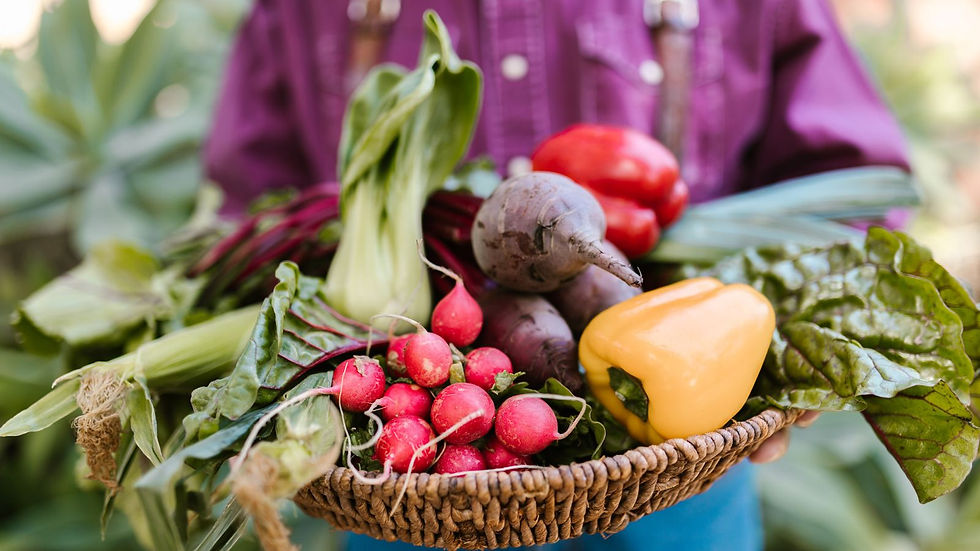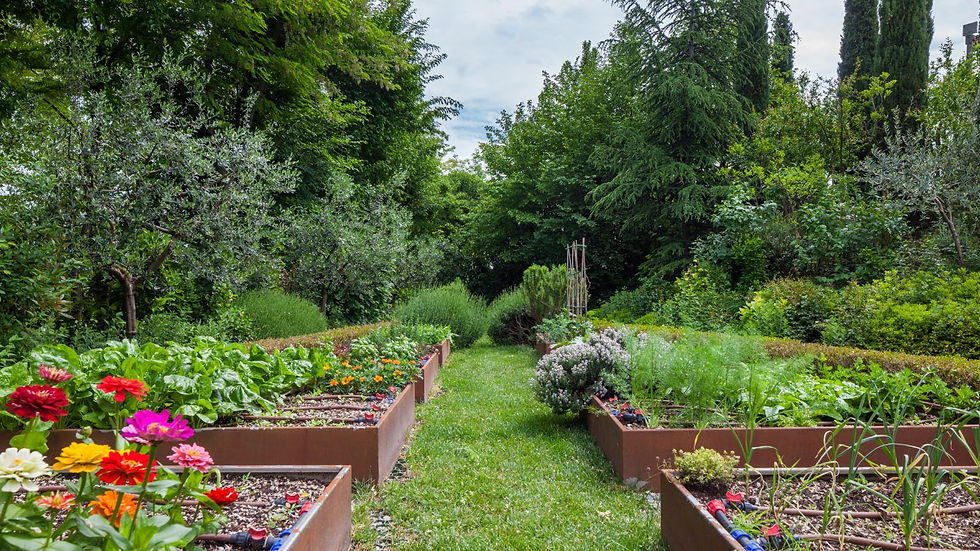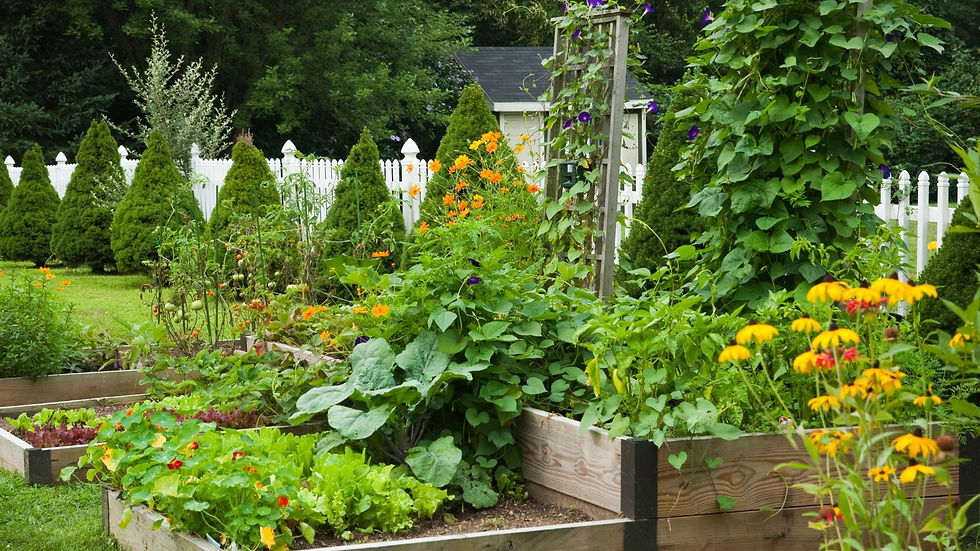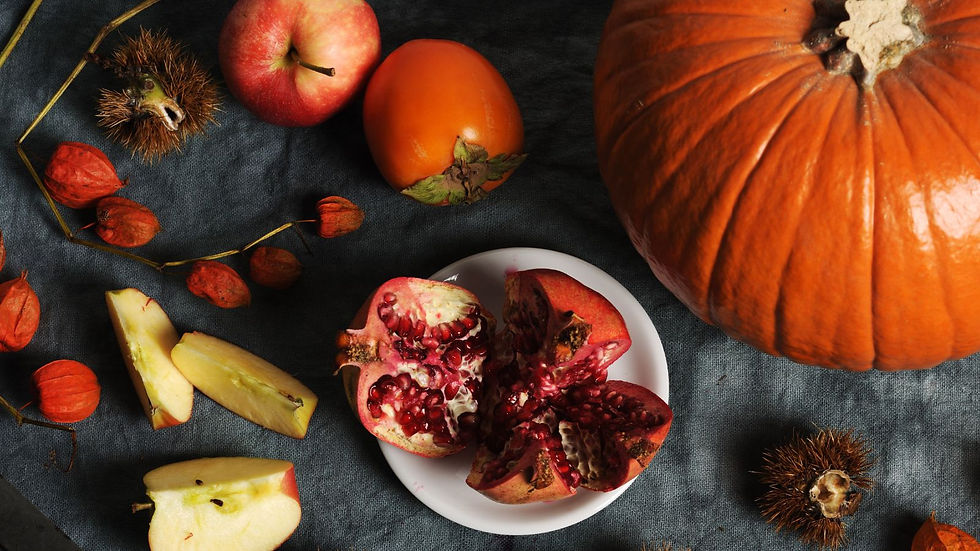Garden Basics for Total Newbies
- b1415jimenez
- Sep 18
- 11 min read

Hi there! If you're totally new to gardening this is the post to get you started - some of my other posts contain vocabulary and concepts that you might not yet be familiar with and so this post is going to break down some of the basics and help encourage you to get digging! Gardening is a highly rewarding hobby which reconnects us, in mind, body and spirit, back to mother earth! This post will cover the Why, the How and even some common terminology at the end!
A life in the garden will bring you into an awareness of the seasons which lots of folks in the modern day are becoming distanced from. We live under roofs in air conditioned homes with window blinds, then get into our air conditioned cars and drive to our jobs in air conditioned buildings and sit down in chairs in front of screens. Our skin misses out on sunshine, which we've been taught to fear, our eyesight is no longer trained on the color of ripe fruit, our bodies are not pushed to work, sweat and move in dynamic ways, our lungs breathe filtered perfumed air. I say all this to put in perspective the value of just a few minutes each day, spent in the garden, experiencing the earth. It will keep you so deeply aware of the seasons, of the wind, the rain, the storms. If you choose to garden vegetables or fruit (and I highly recommend you do give it a try) you will feed yourself and hopefully your family too, with the ever changing bounty of the seasons!
The accomplishment you'll feel serving food you've grown with your own hands - has been felt by generations of ancestors before you, back to the dawn of mankind. Its so so special!
Gardening is a large term encompassing many aspects of agricultural practices both large and small, from fruit or nut tree care to backyard vegetable gardens, flower gardens or simply maintaining decorative trees and shrubs in a yard. Gardening can look like many things and can be successful in a variety of ways. The things you grow, where you grow them and how you care for them is all up to you! Blogs like mine are designed to help gardeners find inspiration and insight from a fellow gardener to help you achieve your goals, whether that be growing more food for your family, growing more flowers or simply designing a peaceful space to enjoy in your yard!

In general the fun of gardening comes from trying new things and (hopefully) finding success as you work toward your dream garden!
One big aspect to gardening successfully is in simply understanding how the change of seasons will effect your plants and knowing which actions to take at which point in the year. At the top of this post you'll find a simplified breakdown of the 4 seasons in relation to growing food - which is where my personal passion lies.
Spring is time to plant warm season crops like tomatoes which will be ready for harvest in summer, the next season. After that harvest, you may choose to also plant cool season crops like Broccoli which again would be harvested in the following season, winter.
Knowing this flow is imperative to your success as a gardener! For example if I planted a tomato plant in October, it would get too cold for the plant to grow up to fruiting age before the cold of winter killed the plant. I would have wasted my time and resources for nothing! Similarly if I planted broccoli in March, the following months would be so warm that the broccoli would struggle to grow and turn to seed and die prematurely!
Warm season and cool season crops like the ones we just discussed are Annual plants, meaning they only grow for 1 season before dying. Beyond edible plants, there are also warm season annual flowers like 'Impatiens' and cool season annual flowers like 'Pansy'!

In the bottom section of the chart above, under annuals you'll see my notes for Perennials. Perennial plants live for several years and so the season we choose to plant in is less important because we are not racing the clock. Although I always recommend perennials be planted in Spring or Fall, the mild seasons, because extreme heat or cold can be stressful to newly planted perennials.
Most perennials, including fruit trees, flower or 'bloom' in the springtime and soon after begin growing their tiny fruits which slowly grow over the season until they become ready for harvest. Some fruits are ready to harvest as soon as late spring, most common stone fruits such as peaches and plums are ready to pick in summer, others like apples and pears are ready later in the year in fall and finally citrus like lemons and oranges are ready in winter. Fruit, berries and nuts are ready to pick when they've reached full size and ripe color. For example; a young orange starts in spring as a tiny, very hard, green sphere, gradually growing bigger and bigger, by wintertime it will reach full size and begin changing color little by little until the rind is fully orange. At this point a gardener may check ripeness by inspecting the fruit for hefty weight and a slight softness when squeezed or by tasting a fruit to see if its reached full sweetness/flavor. Some fruits can be left on the tree a while after they reach peak ripeness, such as citrus, giving you extra days, sometimes even weeks to harvest in. Other fruits, like peaches, which have more delicate tender flesh and thin skin, need to be harvested in a matter of days before they rot and fall to the floor.
My Recommendations for Beginners:
I recommend all beginners start off small and expand slowly as you learn. A good habit is to try at least 1 new type of plant with each new planting season. Start by choosing just a few plants, ones you find either useful or pretty, get a few big pots, plant them and water them as needed through your first season as a gardener! The below sections will go more in depth on exactly how to do that. For specific plant recommendations see my post on that by clicking here!

Sunlight:
Sunlight is a key component of any healthy garden space. I won't dive deep into all the photosynthesis science on you! But just know that plants need light to produce the energy they need to grow. Different plants will also have different sunlight needs. For example your productive warm season tomato plant requires full sun! The place you decide to plant the tomato should not be under a tree, against a fence or anywhere that sunlight will be blocked for a large portion of the day. Monitor your yard over the course of a few days and take note of which areas receive a minimum 6+ hours of full sun daily- a really good spot may get up to or over 8 hours a day! On the flip side, a hydrangea plant, which blooms large flower clusters through the summer, needs a shady or at least partially shady area. The hydrangea plant would burn and die in full sun but would thrive under the shade of a tree or a western fence or building.
Sunlight needs are marked on seed packets and plant tags in the following terms; 'Shade', 'Full Sun', 'Part Sun'. And sometimes plants can adapt to a range of sunlight conditions, in which case they might be marked as 'Shade-Part Sun' or 'Part Sun-Full Sun'. These terms give you a gauge to determine the best spot in your yard or garden for the particular variety.

Soil:
Good soil is a gardeners best friend! I've seen many a gardener quoted saying when you turn your focus to growing soil rather than growing plants, that's when the real success starts taking shape! Soils in different areas of the world can look very different, they can be sandy or rocky or clay-filled to varying degrees. Soil pH, the measure of acidity, also plays a role. Some soils are harder to work in than others. A healthy soil is rich in organic material, teeming with life in the form of microorganisms and worms. A good soil will hold moisture just right, not too much or too little, too much water retention will cause root rot, too little and your plants will die of thirst!
Take a shovel out to your garden side and do some digging. What is it like? Majority of the central valley is either well balanced soils (called 'loam') or heavy soils with a higher concentration of clay which is among one of the easier soil issues to fix. Clay soils turn rock hard when try, almost like a terra cotta pot! In fact there are several areas nearby where clay deposits are so dense you can actually shape it just like store-bought clay! When I was a kid we once dug a big hole in the backyard to discover a perfectly clean layer of grey clay. Another time, more recently, on a fishing trip in the foothills my husband and I stumbled across several large clay deposits, exposed by water erosion, some spots were a light cream clay, others a more orange/red. Anyway! That's enough about playing with wild clay!
If you have heavy clay soil, like many of us in the 209 area do, all you have do do is mix in organic materials! I personally enjoy using aged steer manure and store-bought Kellogg's brand Gromulch, which is like a mini wood chip mix. As these 2 nutritious elements break down their fibers into the soil they'll release lots of nitrogen, which is great for your veggies, and breaks up the clay particles allowing for air pockets and better water drainage. Clay isn't so bad in a way because while it doesn't have great water drainage before adding organic materials, that also means it holds nutrients well. Sandy soils where water slips right through become devoid of nutrients quicker than clay soils. California's clay soils are the secret to the states huge success in agriculture!
Lets say you're starting your garden in pots or raised beds - filling them with the right material is important. I recommend filling with a mix of bagged potting soil, plus GroMulch, plus either bagged compost or aged manure if you can find it. If you happen to have a pet rabbit or sheep their droppings can be thrown directly into the garden. Chicken or cattle manure however is really rich in nitrogen, enough to kill plants from overload, and should be left outside in a pile to age for at least a year before using in the garden.
The main challenge when starting with bagged mixes is that they are sterile soils, meaning the soil production company killed any living organisms or bacteria in the soil to prevent spread of disease. With time over the years though and regular additions of more organic material, even store-bought soil can come back to life!
Some plants are more tolerant of poor soils than others, and some even have preferences based on the origin of a specific variety! For example, a Hydrangea plant enjoys a damp soil while an Agave plant would enjoy a sandy soil reminiscent of the desert! Soil preferences can be found on seed packets and plant tags. This will help you determine which plants will enjoy your soil best!

Water:
Another key component! Water is the lifeline for all living things on earth! Different plants will have different water needs. In general annual flowers and veggies which are fast growing need more sufficient and regular water than larger perennials or trees since these larger plants will send roots far deeper into the soil in search of water. Online you'll find a buzzing world of rules and guides for how much to water but it really all boils down to this - only water when your plants need it. They need it when you can reach your fingers down several inches into the topsoil and the first 2-3 inches is completely bone-dry. Then water just until the amount of water matches what the soil drinks up, if you see the water sit on top of the soil or start to spill, stop watering and check back on it the next day. In our area annuals should be watered about every 2-3 days depending on pot size and rainfall. Larger perennials and trees once weekly through the dry months, up to 2-3 times a week during heat waves.
Weeding:
When most people think of the toils of the garden they often imagine hours upon hours of labor bent over their beds removing weeds. Weeds refer to any plant that decides to grow in a spot where its not wanted. Weeding is most important in the planting seasons for spring and fall annual plants. While the plants are young take time once a week or every other week to remove any weeds around your young plants - this reduces competition for sunlight, water and nutrients. Keep the weekly or biweekly rhythm going through the warm months and you'll notice that as your plants grow big and strong, weeds will be less likely to encroach on their turf since there's less and less space for them. Weeds also grow a lot slower in fall and winter, making that time of year and especially smooth one for gardening.
Days to Harvest:
When it comes to growing annual veggies, most seed packets and plant tags will also note the average days to harvest. This is approximately how many days after planting until you have something to harvest. Plants can vary a lot on growth rate, and so you can play with staggering plants of different days to harvest to space our your harvests. For example, radishes and spinach are super quick, ready to pick in just 30-40 days, tomato plants like a 'Roma' will be ready in 70-80 days at mid-summer and pumpkins can take up to 120 days, being picked in the fall harvest season! Choosing a balance of short, mid and long season crops will ensure you have something to harvest each month! You can also play with succession planting. If you were to succession plant Radish for example; a radish packet comes with several dozen seeds in it, but you likely wont want to eat 30+ radish in a single week! So you can plant just 10 seeds, every 2-3 weeks until you've used up your seed packet(s). This way, by the time you start harvesting the first 10, the second batch will be still a couple weeks out, giving you ample time to enjoy your first harvest before needing to pick more. Short season crops like radishes and leafy greens are really easy to succession, providing you a steady stream of fresh greens all season long!

Gardener Vocabulary:
Variety: a group of plants within a species that share unique, stable, and heritable characteristics, resulting from natural mutations in the wild or by human intervention through crossing breeds to for hybrids or genetic modification. For example, my favorite variety of bush bean to grow in my garden is called 'Provider'.
NPK ratio - a set of three numbers on a fertilizer label that indicates the percentage by weight of Nitrogen (N), Phosphorus (P), and Potassium (K) in the fertilizer. Important because different plants have different nutritional needs, for example Lemon trees enjoy extra Nitrogen!
Germination - when a plant embryo within a seed begins to grow, breaking open to sprout into a seedling/sprout
Annual Plant - a plant that completes its life cycle, from germination to the production of seeds, within one growing season, and then dies, it will not return the next season naturally.
Perennial Plant - plants that live for multiple growing seasons, often for many years, and so do not need to be replanted each season.
Ornamental - plants that are grown for display purposes, rather than functional ones. For example a fruit tree is not an ornamental because it provides an edible harvest whereas a rose bush is planted purely for display.
Cut Flower - a flower or flower bud grown to be harvested from a plant to be used for decoration or in floral arrangements/bouquets. Common cut flower varieties include sunflowers, roses and zinnia.
Deadheading - removing dead flower heads from a plant to encourage further blooming.
'Start' Plant - a young, already established plant that is ready to be planted in a garden, usually purchased from a plant nursery or garden center. These plants provide a head start by skipping the vulnerable germination and early growth stages, making them a popular choice for gardeners who do not want to deal with starting from seeds.
Grow Zone/Hardiness Zone - a geographically defined area that indicates the minimum winter temperature an area typically experiences, helping gardeners determine which perennial plants are likely to survive the winter and thrive in their climate.
Pollination - the process in which pollen is transferred from the male part (anther) of a flower to the female part (stigma) of the same or another flower of the same species, leading to fertilization and the production of seeds and fruit. This transfer is often facilitated by external agents, such as wind, water, or living pollinators like insects, birds, and bats.
Citrus - a tree of the genus (family) that includes citron, lemon, lime, orange, and grapefruit. Native to Asia, citrus trees are widely cultivated in warm countries for their fruit, which is harvested in the winter months.
Stonefruit - a fleshy fruit that has an edible outer layer surrounding a large, hard pit or "stone" which protects a single seed inside. Common examples include peaches, plums, cherries, nectarines, and apricots, most of which are harvested in the warm months of summer or fall.
New gardeners, What other questions do you have about getting started?! Comment below!








Comments